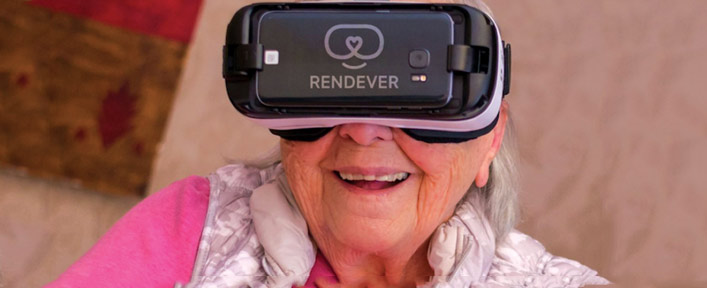
By Gary M. Kaye
Editor, Tech50+ (www.tech50plus.com)
2017 was a big year for connected health. The new administration backed a push for more technological development in healthcare. The Food and Drug Administration (FDA) is improving processes for approving new medical devices and Digital Therapies. Medicare is slowly covering new classes of medical devices such as Dexcom’s CGM (continuous blood glucose monitor). 2017 also saw the annual conference known as the mHealth Summit become the Connected Health Conference and relocate from outside Washington, D.C. to Boston’s World Trade Center.
Computers and medicine
Among the biggest issues addressed by speakers and panels at the Connected Health Conference were those of Artificial Intelligence (AI), Big Data and machine learning. If you’re not familiar with these terms as they apply to healthcare, you might want to take a few minutes and research these cutting edge technologies.
Presentations by Intel, IBM Watson Health, and others addressed both the inevitability and desirability of these forward-thinking approaches to medicine. But there are still privacy and security concerns, as well as issues about what this will mean in terms of the quality of healthcare.
The model is broken
Let’s begin with the premise that the current model of providing healthcare on a one to one basis is broken, and will be even more broken as baby boomers demand an ever-increasing level of medical care and services as they age. Today, when you sit down with a doctor or a specialist, they spend much of their time focused on a diagnosis. They enter data into the computer based on the patient’s description of symptoms and only after that’s done can they begin to think about treatment.
The diagnostic process may consume 90 percent of the visit time, treatment ecommendations get far less. And your doctor is generally working from within his or he own experience base, drawing from experience with hundreds or thousands of patients.
Technology can help
With big data, practitioners have the ability to draw on the information from tens of millions of patients. Instead of limiting the physician to a handful of the tens of thousands of publications out there, machine learning applications hold the hope of being able to digest all of that content and deliver precisely what’s relevant to the case at hand. Artificial Intelligence can sort through the diagnoses and make recommendations on a course of treatment.
None of this limits what the physician can do. On the contrary, these technologies dramatically leverage the knowledge he or she can work with to bring the patient more precise care. Add in the expanding ability of medicine to look at the genomics of an individual and the possibilities for improving so-called precision medicine become almost mind-boggling.
Records, privacy and security
Big data engines gather their data is by drawing on Electronic Medical Records (EMRs) or Electronic Health Records (EHRs). However, patients are often reluctant to share their data for privacy or security concerns. Yet every time a record is added to the database, it becomes one more point that can help the next patient with a diagnosis. The way it’s done, only information about the condition, disease, etc. is pulled into the mix, not names or other identification – such as a social security number – that would tie an individual to the data. It cannot be disaggregated to identify a single patient.
Though big data isn’t a threat, patients should still be concerned about the security of their records, especially anything that would disclose personal information such as name, address or Social Security number. Unfortunately, that information could theoretically be used by insurers or employers to discriminate based on genomic tendencies or pre-existing conditions.
Tech and elders
There was a lot of new and innovative technology at the Connected Health Conference.
One area that’s creating a lot of buzz is virtual reality (VR). Rendever demonstrated the system they are using in an institutional setting to help the elderly fight off dementia. The system also has benefits in helping the elderly deal with issues of social isolation by allowing them to revisit their old neighborhoods. Another company doing VR for the elderly is One Caring Team, creator of Aloha VR. Its approach is somewhat different, aimed at individuals who are more likely to be at home than in an institution. They work with the families to create unique content designed for each patient.
Cedars-Sinai Hospital in Los Angeles unveiled a program it has created using virtual reality to mitigate pain in hospitalized patients. According to the hospital, the therapy can reduce pain by up to 25 percent. The aim is to create an environment that will allow patients to be distracted from their pain by taking a virtual walk on a beach or a hike through the woods.
Wearables and health
There were many wearable companies on the exhibit floor. Fitbit’s Health Group showed off the health benefits of its fitness trackers, now being used in a variety of wellness programs by companies such as Qualcomm, United Healthcare, the Cleveland Clinic, Virgin Pulse and others.
BeWell Connect displayed its suite of medical grade wearables and a device that does vital sign monitoring – called VisioCheck – that is a fraction of the size of the devices in hospitals and ideal for remote patient visits and visiting nurse services.
Sensogram Technologies makes the SensoSCAN, a device that sits at the end of your finger and can continuously measure heart rate, blood pressure, oxygen level and respiration while you are awake or asleep, allowing it to spot anomalies like sleep apnea. Data is downloaded to an app and shared with your caregiver.
Gary Kaye is the creator of Tech50+ (www.tech50plus.com), the leading website covering technology from the Baby Boomer perspective. Kaye has been covering high tech for more than 30 years with outlets including NBC, ABC, CNN and Fox Business. He is a regular contributor to AARP and other websites on issues regarding the nexus of technology, seniors and baby boomers.